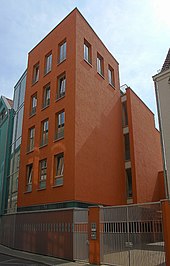Monasteries in Bremen
The medieval monasteries in Bremen have not been preserved. Historically there was the St. Paul monastery in Bremen , the Dominican monastery St. Katharinen, the Franciscan monastery St. Johannis and the commandery of the Teutonic Order . In 1522 the Lutheran Augustinian Heinrich von Zütphen came through Bremen and preached in the Ansgariikirche . The ensuing Reformation in Bremen led to the Lutheran faith prevailing in Bremen and the monasteries were therefore dissolved. The Birgitten Monastery has existed since 2002.
St. Paul Monastery
→ Main article: St. Paul Monastery (Bremen) The former monastery of St. Paul the Benedictines in the western part of today's Ostertorsteinviertel has not been preserved. It existed from 1050 to 1523.
Dominican monastery of St. Catherine
→ Main article: St. Catherine's Monastery (Bremen) The Dominicans settled in Bremen in 1225. They found the St. Katharinen monastery.
Around 1253 construction of the monastery began in the old town between Sögestraße , Unser-Lieben-Frauen-Kirchhof and Domshof . The monastery consisted of the three-aisled hall church , the cloister courtyard with the cloister , the farmyard, the remter , the refectory and the other lounges and utility rooms. The remains of the Gothic monastery, Katharinenstrasse, the Katharinenklosterhof and the Katharinenpassage are reminiscent of the monastery. In 1524, as a result of the Reformation, the first Dominicans - u. a. the abbot and the reading master - expelled. The monastery was closed in 1528.
The Latin school (see Altes Gymnasium ) and, from 1898, the Historical Museum (see Focke Museum ) are set up in their rooms. The church building was then the city's armory. In the 19th century the church was also a warehouse. After the church was partially demolished, the remains remained until it was finally destroyed in World War II.
The remains of the monastery - u. a. the Remter - are now overbuilt by the Katharinen-Hochgarage and the Katharinen-Passage. They have been a listed building since 1973 (see here )
Franciscan monastery of St. Johannis
→ Main article: St. John's Monastery (Bremen)

The Franciscans probably also settled in Bremen in 1225. The monastery was in the old town . The St. Johann monastery church, Klosterkirchenstraße and Klosterortstraße are reminiscent of the monastery.
The construction of the monastery began around 1258. It consisted of the three-aisled Gothic church of St. Johann from the 14th century, which has been preserved today and which was enlarged to become a hall church in the 15th century . Added to this were the monastery buildings and courtyards on the south side, which have not been preserved today.
Around 20 to 30 Franciscans lived in the monastery in the 14th to 16th centuries. The monastery was closed in 1528 after the Reformation. The monastery buildings were then used to house the mentally weak (madhouse). In 1834 the now dilapidated monastery buildings were torn down and residential buildings were built on the site. The church was u. a. Hospital church and until 1801 the church of Reformed (“French”) parishes.
In 1823, after a thorough renovation, the Church of St. Johann was re-consecrated as the first Roman Catholic parish church in Bremen after the Reformation.
In 1856 the first Catholic women religious came to the St. Johannis congregation and taught in the St. Johannis School until 1803. They left Bremen because they were no longer allowed to teach in the religious habit. The Franciscan Sisters of Thuine take on the school services and the care of a St. John's kindergarten in Walle .
In 1869 the Franciscan Sisters of Mauritz took over the care and support services in the newly founded St. Joseph Stift.
In addition, there is a convent of the Franciscan Sisters in the immediate vicinity of the St. Johann Provost Church.
Commandery of the Teutonic Order
→ Main article: Commandery of the Teutonic Order in Bremen
The Teutonic Order , which was founded by crusaders from Bremen and Lübeck during the siege of Akkon (1189–1191) during the Third Crusade, established a commandery in Bremen as early as 1230 . A small single-nave church with only two bays and an attached religious house were built near Spittal. The existing Heiliggeist Hospital was taken over and soon referred to as the "German House". The hospital was closed in 1426 and the house was mentioned for the last time in 1519. The commandery was at the Ostertor in the old town. The Komturstraße reminiscent of the location.
The Teutonic Knights took part in 1234 in the "crusade" against the Stedinger in Stedingerkrieg .
Only a few friars were in Bremen and only one or two religious priests were active until 1450. The order turned into a prosperous business enterprise. Although the order began to change during the Reformation, Commander Rolf von Bardewisch and four of his soldiers were killed by the angry Bremen citizens at the beginning of the uprising of 104 men in 1531 . In 1564 Bremen acquired the commandery and the 31 farms belonging to it. The last Lutheran commander lived and managed the property until 1583.
From 1674 the church was only a warehouse and a packing house. The remains of the building were bombed during World War II and partially demolished in 1956. The lower church remained under the courthouse - from 1976 onwards as the "Commandery" restaurant.
The Jesuits
From 1648 to 1788 - shortly after the Jesuits were banned in 1773 - the Jesuits worked in Bremen, some of them fathers as "court chaplains" of the imperial resident. But they also work unofficially for the citizens and workers of the Catholic faith, at a time when the Catholic Church is not represented in Bremen. Her house was initially in the old town and from 1651 in the new town . The Jesuits did not work again in Bremen until 1963 in the “ Peter Faber House” with a chapel in Schwachhausen at Schwachhauser Ring 151. In 1990 their branch was closed.
Nuns and Beguines in Bremen
There were only a few nuns or nuns in medieval Bremen.
- Beguines and beguinages : Beguines have been active in Lilienthal since the beginning of the 13th century and then at St. Katharinen since 1258 and are thus connected to the Dominican order in pastoral care. Another beguinage was at the St. Nikolaikirche, which was built in 1260/70 and partially demolished around 1650. The Beguines, unmarried women from the bourgeois upper classes, survived - now Lutheran - the Reformation in Bremen. They lived in houses on Hutfilterstrasse and then at the bowl basket . From 1828 there was the Katharinenstift, which moved to Parkallee in 1912 . The road In the Beguinage was named after the beguines .
- The beguinage in Neustadt had only been a cooperative residential community since 2001, as was the project in Horn on Nernstrasse.
- Birgittenkloster: In 2002 the Birgittenkloster in Schnoor was consecrated for the nuns of the Birgittenorder .
Other Catholic religious activities
- The Catholic St. Theresienhaus in Vegesack was looked after from 1927 to 1989 by the Missionary Sisters of the Holy Name of Mary, also known as "Nice Sisters" after the headquarters of the mother house of the religious order in Osnabrück-Nette. Some sisters worked in the Catholic St. Elisabeth House in Schwachhausen until 1999 .
- From 1959 to 2003 women worked at the Secular Institute St. Bonifatius in Bremen and looked after the St. Michael elderly center in Neustadt an der Kornstraße .
- Dutch fathers have been looking after the St. Pius congregation in Huchting since 1963 .
- In the district of Gartenstadt Vahr (Rethemer Straße) there has been a monastery of the Martha Sisters who are active in Caritas and senior care since 2000 .
literature
- Wilhelm Tacke : Monasteries in Bremen . Edition Temmen, Bremen 2005, ISBN 3-86108-545-3 .
- Herbert Black Forest : The Great Bremen Lexicon . Edition Temmen, Bremen 2003, ISBN 3-86108-693-X .
- Dieter Hägermann , Ulrich Weidinger, Konrad Elmshäuser : Bremen Church History in the Middle Ages, Hauschild, Bremen 2012, pp. 377–418, ISBN 978-3-89757-170-9 .



